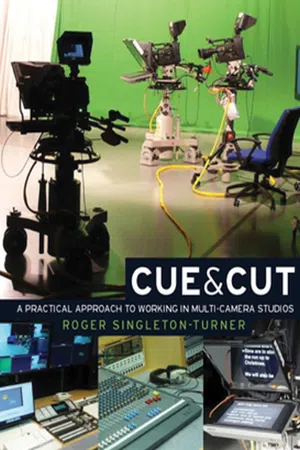
Cue and Cut
A practical approach to working in multi-camera studios
Roger Singleton-Turner
- English
- ePUB (mobile friendly)
- Available on iOS & Android
Cue and Cut
A practical approach to working in multi-camera studios
Roger Singleton-Turner
About This Book
Cue & Cut is a 'practical approach to working in television studios' for anyone who might want to work in that medium. It's full of useful information about kit, and how you would use it to create multi-camera content. Written by a multi-camera producer-director with years of drama and teaching experience, it presents both a way of handling studios and a source of information about how things have changed from the days of monochrome to HD tapeless modes - with some thoughts on 3D HDTVThe book is firmly based in first-hand teaching experience and experience of producing, direction, floor managing (and so on) and on working with top flight Actors, Writers, Musicians, Designers of all disciplines and Sound and Camera crews, both at the BBC and in ITV. The book will certainly cover multi-camera aspects of Undergraduate, HND and B.Tech courses and should be useful to those on short courses, whether practical or post-graduate.
Frequently asked questions
Information
- your own protection; and
- your responsibility to others.

- Before moving microphones, be sure they are faded down on the sound desk.
- With any voltage, there is a danger of shock. This – and any possible damage to equipment – is made worse by contact with water. Even a personal mike may work off 12 volts. Spilling water on, say, a lapel mike could therefore cause a nasty, if not life-threatening, shock.
- Loud and prolonged sound can cause pain and can damage your hearing. Working close to powerful loudspeakers, with high levels in headphones or where howl-round is accidentally fed into headphones can be particularly dangerous. Working close to other loud sound-sources like jet engines and some industrial equipment causes the same range of problems. Appropriate ear-protection must be worn whenever appropriate – otherwise you could go deaf! (This warning is repeated under ‘Microphones & sound’).
- Avoid plunging the studio into total darkness – this can be very dangerous.
- When adjusting a light or its filters, remember that they heat up quickly. Use appropriate gloves! Also, check that safety chains for lights and filters are properly secured.
- Check that safety gauzes are in place whenever it is appropriate. (These ensure that, if a bulb does explode, the studio is not showered with shards of red-hot glass.)
- Ensure that no cable is left dangling against a light (it could burn through) and that, in rotating a light, cables are not stretched (also see next section).
- No smoking, no food, no drink is allowed in any TV studio, unless it is an essential part of the action.
- Never stand on cables. Never place anything on cables. Camera cables in particular are fr...
Table of contents
- Cover
- Half Title Page
- Title Page
- Copyright Page
- Contents
- List of Illustrations
- List of Tables
- Preface
- Acknowledgements
- List of Abbreviations
- Introduction
- Part I: Safety and Good Practice
- Part II: Introduction to the Studio
- Part III: Content
- Part IV: Applying the Principles
- Afterword
- Appendix I: aspect ratios
- Appendix II: continuity – a summary
- Select videography
- Bibliography and references
- Suggested further reading
- Index